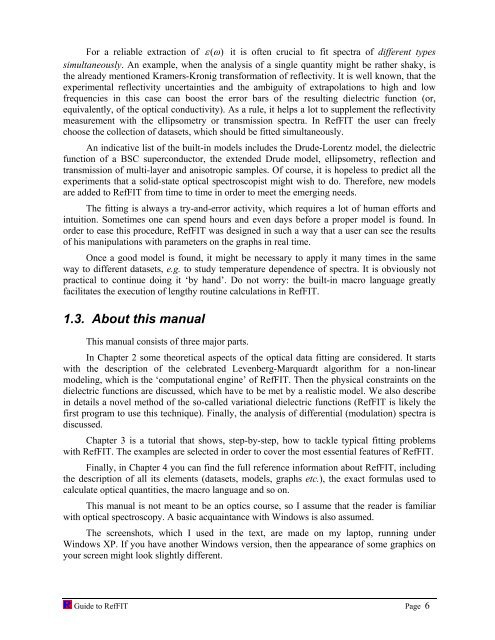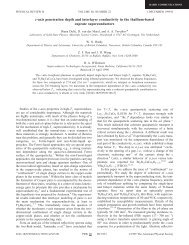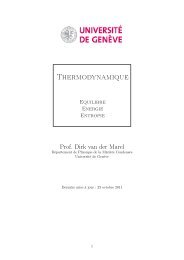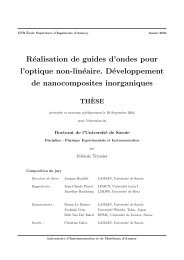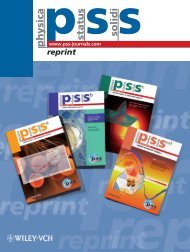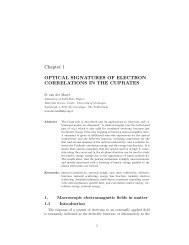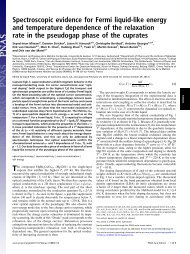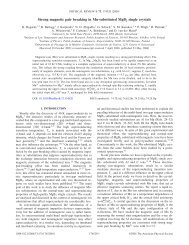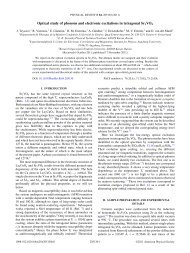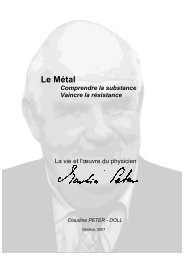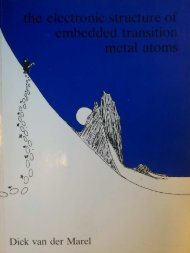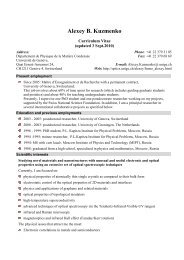software to fit optical spectra - Quantum Materials Group
software to fit optical spectra - Quantum Materials Group
software to fit optical spectra - Quantum Materials Group
You also want an ePaper? Increase the reach of your titles
YUMPU automatically turns print PDFs into web optimized ePapers that Google loves.
For a reliable extraction of ε (ω)<br />
it is often crucial <strong>to</strong> <strong>fit</strong> <strong>spectra</strong> of different types<br />
simultaneously. An example, when the analysis of a single quantity might be rather shaky, is<br />
the already mentioned Kramers-Kronig transformation of reflectivity. It is well known, that the<br />
experimental reflectivity uncertainties and the ambiguity of extrapolations <strong>to</strong> high and low<br />
frequencies in this case can boost the error bars of the resulting dielectric function (or,<br />
equivalently, of the <strong>optical</strong> conductivity). As a rule, it helps a lot <strong>to</strong> supplement the reflectivity<br />
measurement with the ellipsometry or transmission <strong>spectra</strong>. In RefFIT the user can freely<br />
choose the collection of datasets, which should be <strong>fit</strong>ted simultaneously.<br />
An indicative list of the built-in models includes the Drude-Lorentz model, the dielectric<br />
function of a BSC superconduc<strong>to</strong>r, the extended Drude model, ellipsometry, reflection and<br />
transmission of multi-layer and anisotropic samples. Of course, it is hopeless <strong>to</strong> predict all the<br />
experiments that a solid-state <strong>optical</strong> spectroscopist might wish <strong>to</strong> do. Therefore, new models<br />
are added <strong>to</strong> RefFIT from time <strong>to</strong> time in order <strong>to</strong> meet the emerging needs.<br />
The <strong>fit</strong>ting is always a try-and-error activity, which requires a lot of human efforts and<br />
intuition. Sometimes one can spend hours and even days before a proper model is found. In<br />
order <strong>to</strong> ease this procedure, RefFIT was designed in such a way that a user can see the results<br />
of his manipulations with parameters on the graphs in real time.<br />
Once a good model is found, it might be necessary <strong>to</strong> apply it many times in the same<br />
way <strong>to</strong> different datasets, e.g. <strong>to</strong> study temperature dependence of <strong>spectra</strong>. It is obviously not<br />
practical <strong>to</strong> continue doing it ‘by hand’. Do not worry: the built-in macro language greatly<br />
facilitates the execution of lengthy routine calculations in RefFIT.<br />
1.3. About this manual<br />
This manual consists of three major parts.<br />
In Chapter 2 some theoretical aspects of the <strong>optical</strong> data <strong>fit</strong>ting are considered. It starts<br />
with the description of the celebrated Levenberg-Marquardt algorithm for a non-linear<br />
modeling, which is the ‘computational engine’ of RefFIT. Then the physical constraints on the<br />
dielectric functions are discussed, which have <strong>to</strong> be met by a realistic model. We also describe<br />
in details a novel method of the so-called variational dielectric functions (RefFIT is likely the<br />
first program <strong>to</strong> use this technique). Finally, the analysis of differential (modulation) <strong>spectra</strong> is<br />
discussed.<br />
Chapter 3 is a tu<strong>to</strong>rial that shows, step-by-step, how <strong>to</strong> tackle typical <strong>fit</strong>ting problems<br />
with RefFIT. The examples are selected in order <strong>to</strong> cover the most essential features of RefFIT.<br />
Finally, in Chapter 4 you can find the full reference information about RefFIT, including<br />
the description of all its elements (datasets, models, graphs etc.), the exact formulas used <strong>to</strong><br />
calculate <strong>optical</strong> quantities, the macro language and so on.<br />
This manual is not meant <strong>to</strong> be an optics course, so I assume that the reader is familiar<br />
with <strong>optical</strong> spectroscopy. A basic acquaintance with Windows is also assumed.<br />
The screenshots, which I used in the text, are made on my lap<strong>to</strong>p, running under<br />
Windows XP. If you have another Windows version, then the appearance of some graphics on<br />
your screen might look slightly different.<br />
Guide <strong>to</strong> RefFIT Page 6


